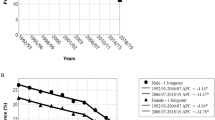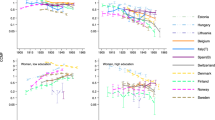Abstract
Previous studies have demonstrated a modest association between smoking and leukemia particularly for myeloid disorders. Our objective was to examine whether changing trends in cigarette smoking prevalence nationally and within selected states parallel similar trends in mortality from leukemia. Trends in national smoking rates were correlated with trends in leukemia mortality rates obtained from the Centers for Disease Control and Prevention and the Surveillance Epidemiology and End Results registry, respectively. State-specific correlations were assessed from 1984 to 2004 using smoking prevalence data from the Behavioral Risk Factor Surveillance System and leukemia mortality data from National Vital Statistics System. Correlations were computed using the Spearman rank correlation coefficient. Leukemia mortality decreased overall in the United States in parallel with decreased smoking. Analyzed on a state-specific basis, leukemia mortality decreased in states where smoking rates declined markedly but remained unchanged where smoking prevalences were relatively stable. The findings suggest that declining rates of leukemia mortality are associated with changing patterns of smoking behavior.


Similar content being viewed by others
References
The Health Consequences of Smoking: A Report of the Surgeon General. Atlanta, GA: U.S. Department of Health and Human Services, Centers for Disease Control and Prevention, National Center for Chronic Disease Prevention and Health Promotion, Office on Smoking and Health. DHHS, 2004
Kane EV, Roman E, Cartwright R, Parker J, Morgan G (1999) Tobacco and the risk of acute leukaemia in adults. Br J Cancer 81:1228–1233
Lyon F (2004) W. H. O., International Agency for Research on Cancer. Tobacco Smoke and Involuntary Smoking. IARC Working Group on the Evaluation of Carcinogenic Risk to Humans 83
Korte JE, Hertz-Picciotto I, Schulz MR, Ball LM, Duell EJ (2000) The contribution of benzene to smoking-induced leukemia. Environ Health Perspect 108:333–339
Snyder R (2002) Benzene and leukemia. Crit Rev Toxicol 32:155–210
DeMarini DM (2004) Genotoxicity of tobacco smoke and tobacco smoke condensate: a review. Mutat Res 567:447–474
Corre F, Lellouch J, Schwartz D (1971) Smoking and leucocyte-counts. Results of an epidemiological survey. Lancet 2:632–634
Tollerud DJ, Clark JW, Brown LM, Neuland CY, Mann DL, Pankiw-Trost LK, Blattner WA, Hoover RN (1989) The effects of cigarette smoking on T cell subsets. A population-based survey of healthy caucasians. Am Rev Respir Dis 139:1446–1451
Centers for disease prevention and control, N. H. I. S., Selected Years-United States. Percentage of adults who were current, former, or never smokers, overall and by sex, race, Hispanic origin, age, education, and poverty status 1965–2006
Lag, R. SEER Cancer Statistics Review, 1975–2004, National Cancer Institute. Bethesda, MD. Based on November 2006 SEER data submission
Centers for Disease Control and Prevention. 2008. www.cdc.gov/
Surveillance, Epidemiology and End Results (SEER) Program. 2008. seer.cancer.gov/
Percentage of adults who are current cigarette smokers 1965–2007. Survey: N.H.I.
Behavioral Risk Factor Surveillance System (BRFSS). www.cdc.gov/brfss/
National Vital Statistics System (NVSS). www.cdc.gov/nchs/nvss.htm
Crane MM, Strom SS, Halabi S, Berman EL, Fueger JJ, Spitz MR, Keating MJ (1996) Correlation between selected environmental exposures and karyotype in acute myelocytic leukemia. Cancer Epidemiol Biomarkers Prev 5:639–644
Sandler DP, Shore DL, Anderson JR, Davey FR, Arthur D, Mayer RJ, Silver RT, Weiss RB, Moore JO, Schiffer CA et al (1993) Cigarette smoking and risk of acute leukemia: associations with morphology and cytogenetic abnormalities in bone marrow. J Natl Cancer Inst 85:1994–2003
Bjork J, Albin M, Mauritzson N, Stromberg U, Johansson B, Hagmar L (2001) Smoking and acute myeloid leukemia: associations with morphology and karyotypic patterns and evaluation of dose-response relations. Leuk Res 25:865–872
Davico L, Sacerdote C, Ciccone G, Pegoraro L, Kerim S, Ponzio G, Vineis P (1998) Chromosome 8, occupational exposures, smoking, and acute nonlymphocytic leukemias: a population-based study. Cancer Epidemiol Biomarkers Prev 7:1123–1125
Moorman AV, Roman E, Cartwright RA, Morgan GJ (2002) Smoking and the risk of acute myeloid leukaemia in cytogenetic subgroups. Br J Cancer 86:60–62
Mrózek K, Bloomfield CD (2006) Chromosome aberrations, gene mutations and expression changes, and prognosis in adult acute myeloid leukemia. Hematology Am Soc Hematol Educ Program 169–177
Chelghoum Y, Danaila C, Belhabri A, Charrin C, Le QH, Michallet M, Fiere D, Thomas X (2002) Influence of cigarette smoking on the presentation and course of acute myeloid leukemia. Ann Oncol 13:1621–1627
Chang G, Orav EJ, McNamara T, Tong MY, Antin JH (2004) Depression, cigarette smoking, and hematopoietic stem cell transplantation outcome. Cancer 101:782–789
Yates J, Glidewell O, Wiernik P, Cooper MR, Steinberg D, Dosik H, Levy R, Hoagland C, Henry P, Gottlieb A, Cornell C, Berenberg J, Hutchison JL, Raich P, Nissen N, Ellison RR, Frelick R, James GW, Falkson G, Silver RT, Haurani F, Green M, Henderson E, Leone L, Holland JF (1982) Cytosine arabinoside with daunorubicin or adriamycin for therapy of acute myelocytic leukemia: a CALGB study. Blood 60:454–462
Acknowledgments
Supported partially by grants from the National Cancer Institute Grant CA16056 (RV, MKC, AJH, ESW, MW), the Szefel Foundation (ESW), the Heidi Leukemia Research Fund (MW), and the Nancy C. Cully Endowment for Leukemia Research (MW), Buffalo, NY, USA.
Author information
Authors and Affiliations
Corresponding author
Additional information
Author Contribution
Dr. Varadarajan collected the data and wrote the manuscript.
Dr. Cummings reviewed the data and assisted in manuscript preparation.
Dr. Hyland analyzed the data.
Dr. Wang reviewed the data and assisted in manuscript preparation.
Dr. Wetzler oversaw the conduct of the study and contributed to the manuscript preparation.
All authors reviewed the final manuscript and approved it.
Rights and permissions
About this article
Cite this article
Varadarajan, R., Cummings, M.K., Hyland, A.J. et al. Can decreasing smoking prevalence reduce leukemia mortality?. Ann Hematol 89, 873–876 (2010). https://doi.org/10.1007/s00277-010-0957-6
Received:
Accepted:
Published:
Issue Date:
DOI: https://doi.org/10.1007/s00277-010-0957-6




